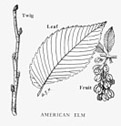AMERICAN ELM
white elm
Ulmus americana Linnaeus
|
| American elm is one of the most beautiful, graceful, and best known forest trees in New York. It occupies a wide range of sites, though typically a tree of the bottomlands, and grows to be one of the largest trees in the state. (The Gowanda elm had a basal circumference of 39 feet.) The wood is heavy, hard, strong, tough, coarse-grained, difficult to split, and light brown in color; largely used for veneer, barrel staves and hoops, crates and wheel hubs. The graceful symmetry of the crown makes the elm highly prized for ornamental planting. However, this species has nearly disappeared from our parks and streets because of the lethal Dutch Elm disease. Improved resistant strains have been developed and planted ornamentally and in the wild in hopes that this majestic species can regain its former widespread occurence. |
| Bark - dark gray in color, divided by irregular up-and-down furrows into broad flat-topped ridges, rather firm or occasionally in old trees flaking off; inner bark in alternate layers of brown and white.Twigs - slender, smooth, reddish brown in color, not mucilaginous (like glue) when chewed. Winter buds - winter twig obviously ends in leaf scar, hence larger bud near end of twig not truly terminal; lateral buds somewhat smaller, ovate, pointed, light reddish brown in color, smooth, 1/8 inch long. Leaves - simple, alternate, 4 to 6 inches long, oblique at the base, margin doubly serrate, at maturity dark green in color above, lighter beneath, midrib and parallel veins prominent; upper surface of leaf somewhat rough to the touch, although not so pronounced as in slippery elm. Fruit - flat, winged, deeply notched at the end, 1/2 inch long, containing one small seed; in clusters, ripens in early May as the leaf buds unfold, falling soon thereafter. Distinguishing features - zigzag twigs; inner bark not mucilaginous, having alternate layers of brown and white; leaf slightly rough on upper side only; with oblique base. |

No comments:
Post a Comment